Resources
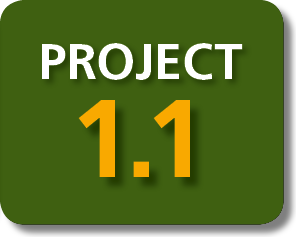
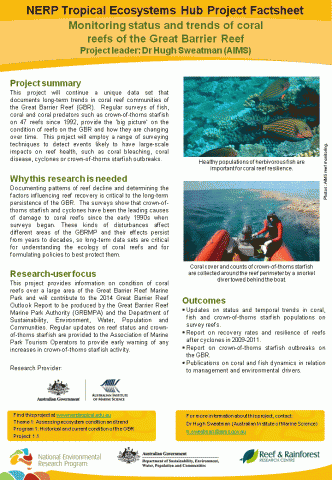 This project will continue a unique data set that documents long-term trends in coral reef communities of the Great Barrier Reef (GBR). Regular surveys of fish, coral and coral predators such as crown-of-thorns starfish on 47 reefs since 1992, provide the ‘big picture’ on the condition of reefs on the GBR and how they are changing over time. This project will employ a range of surveying techniques to detect events likely to have large-scale impacts on reef health, such as coral bleaching, coral disease, cyclones or crown-of-thorns starfish outbreaks.
This project will continue a unique data set that documents long-term trends in coral reef communities of the Great Barrier Reef (GBR). Regular surveys of fish, coral and coral predators such as crown-of-thorns starfish on 47 reefs since 1992, provide the ‘big picture’ on the condition of reefs on the GBR and how they are changing over time. This project will employ a range of surveying techniques to detect events likely to have large-scale impacts on reef health, such as coral bleaching, coral disease, cyclones or crown-of-thorns starfish outbreaks.
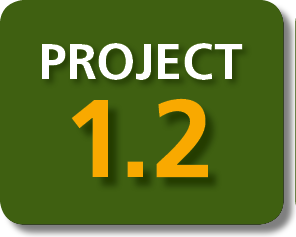
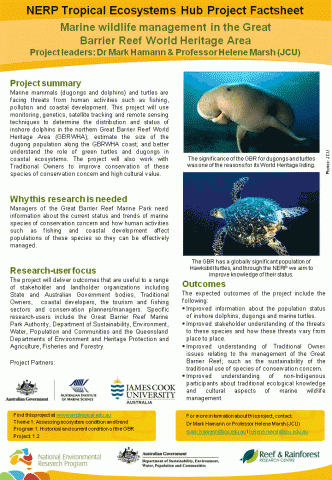 Marine mammals (dugongs and dolphins) and turtles are facing threats from human activities such as fishing, pollution and coastal development. This project will use monitoring, genetics, satellite tracking and remote sensing techniques to determine the distribution and status of inshore dolphins in the northern Great Barrier Reef World Heritage Area (GBRWHA); estimate the size of the dugong population along the GBRWHA coast; and better understand the role of green turtles and dugongs in coastal ecosystems. The project will also work with Traditional Owners to improve conservation of these species of conservation concern and high cultural value.
Marine mammals (dugongs and dolphins) and turtles are facing threats from human activities such as fishing, pollution and coastal development. This project will use monitoring, genetics, satellite tracking and remote sensing techniques to determine the distribution and status of inshore dolphins in the northern Great Barrier Reef World Heritage Area (GBRWHA); estimate the size of the dugong population along the GBRWHA coast; and better understand the role of green turtles and dugongs in coastal ecosystems. The project will also work with Traditional Owners to improve conservation of these species of conservation concern and high cultural value.

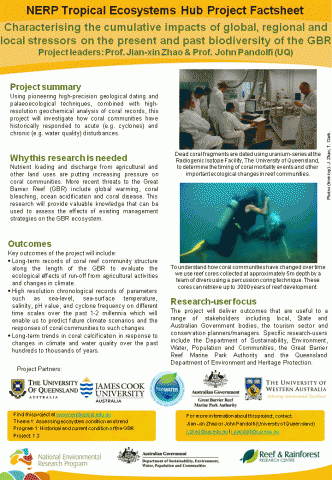 Using pioneering high-precision geological dating and palaeoecological techniques, combined with high-resolution geochemical analysis of coral records, this project will investigate how coral communities have historically responded to acute (e.g. cyclones) and chronic (e.g. water quality) disturbances.
Using pioneering high-precision geological dating and palaeoecological techniques, combined with high-resolution geochemical analysis of coral records, this project will investigate how coral communities have historically responded to acute (e.g. cyclones) and chronic (e.g. water quality) disturbances.

This project will engage with stakeholders in the region to design and implement the initial stages of a long-term social and economic monitoring program. The program will provide information for coastal planners and managers about local and regional communities, traditional owners, marine tourism, commercial and recreational fishing, catchment industries, ports and shipping. The addition of a long-term social and economic monitoring program will augment existing long-term biophysical monitoring of the Great Barrier Reef (GBR) and increase the effectiveness of it s management.
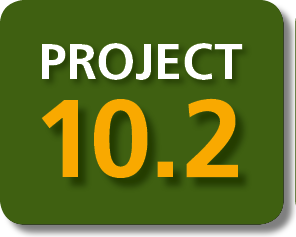
 The Great Barrier Reef (GBR) is famous for its spectacular coral, rich biodiversity and natural beauty. However, none of these important assets are bought or sold in the marketplace, so none are explicitly ‘valued’ with a price. Recognising that absence of price does not mean absence of value, this project seeks to improve our understanding of these non-market ‘values’ to a variety of different stakeholders. How important are pristine beaches, iconic marine mammals or healthy coral reefs to the community, tourists and the tourism industry? How would people feel if some of these ‘values’ were degraded (e.g. if water clarity declined, or if fish were less abundant)?
The Great Barrier Reef (GBR) is famous for its spectacular coral, rich biodiversity and natural beauty. However, none of these important assets are bought or sold in the marketplace, so none are explicitly ‘valued’ with a price. Recognising that absence of price does not mean absence of value, this project seeks to improve our understanding of these non-market ‘values’ to a variety of different stakeholders. How important are pristine beaches, iconic marine mammals or healthy coral reefs to the community, tourists and the tourism industry? How would people feel if some of these ‘values’ were degraded (e.g. if water clarity declined, or if fish were less abundant)?
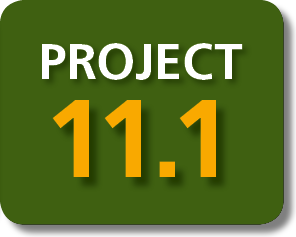
This project is exploring potential future scenarios for the Torres Strait and will identify ‘no regrets’ strategies to improve livelihoods and achieve sustainable economic development. The project will help to deliver ongoing initiatives promoting climate adaptation, alternative livelihoods and economic development in the region.

 This project focuses on improving methods to detect the introduction of exotic animal diseases into the Torres Strait The researchers will examine the environmental factors that influence the establishment and persistence of wildlife diseases in the region. They will study insect disease vectors and the incidence of disease in birds in a range of habit.
This project focuses on improving methods to detect the introduction of exotic animal diseases into the Torres Strait The researchers will examine the environmental factors that influence the establishment and persistence of wildlife diseases in the region. They will study insect disease vectors and the incidence of disease in birds in a range of habit.
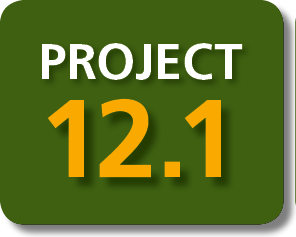
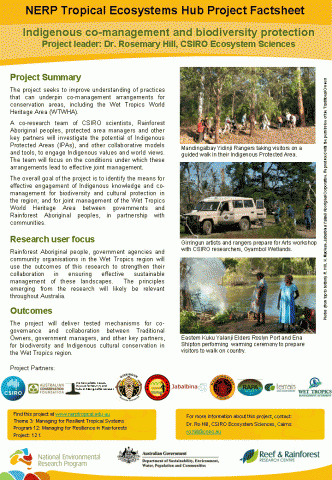 The project seeks to improve understanding of practices that can underpin co-management arrangements for conservation areas, including the Wet Tropics World Heritage Area (WTWHA).
The project seeks to improve understanding of practices that can underpin co-management arrangements for conservation areas, including the Wet Tropics World Heritage Area (WTWHA).
A co-research team of CSIRO scientists, Rainforest Aboriginal peoples, protected area managers and other key partners will investigate the potential of Indigenous Protected Areas (IPAs), and other collaborative models and tools, to engage Indigenous values and world views. The team will focus on the conditions under which these arrangements lead to effective joint management.
The overall goal of the project is to identify the means for effective engagement of Indigenous knowledge and co-management for biodiversity and cultural protection in the region; and for joint management of the Wet Tropics World Heritage Area between governments and Rainforest Aboriginal peoples, in partnership with communities.

The project will assist decision-makers to more efficiently restore biodiversity to degraded rainforest landscapes by providing new knowledge about the outcomes of lower-cost natural regeneration (including potential for minimum intervention management) relative to higher-cost active reforestation (replanting). The outcomes of this project will enable planners to assess the costs, risks and benefits of different approaches to reforestation and choose the most appropriate method for any particular ecological and economic context.

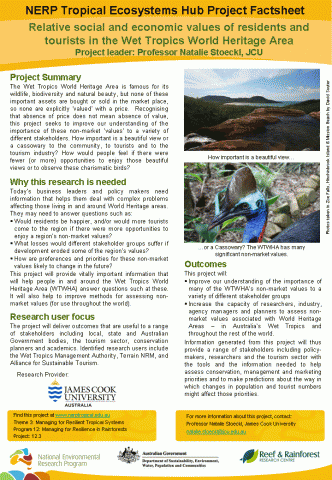 The Wet Tropics World Heritage Area is famous for its wildlife, biodiversity and natural beauty, but none of these important assets are bought or sold in the market place, so none are explicitly ‘valued’ with a price. Recognising that absence of price does not mean absence of value, this project seeks to improve our understanding of the importance of these non-market ‘values’ to a variety of different stakeholders. How important is a beautiful view or a cassowary to the community, to tourists and to the tourism industry? How would people feel if there were fewer (or more) opportunities to enjoy those beautiful views or to observe these charismatic birds?
The Wet Tropics World Heritage Area is famous for its wildlife, biodiversity and natural beauty, but none of these important assets are bought or sold in the market place, so none are explicitly ‘valued’ with a price. Recognising that absence of price does not mean absence of value, this project seeks to improve our understanding of the importance of these non-market ‘values’ to a variety of different stakeholders. How important is a beautiful view or a cassowary to the community, to tourists and to the tourism industry? How would people feel if there were fewer (or more) opportunities to enjoy those beautiful views or to observe these charismatic birds?


